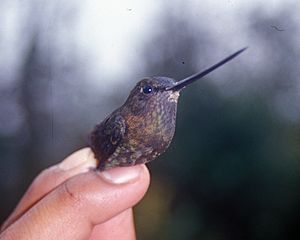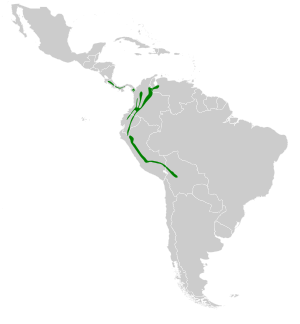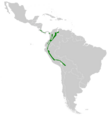Green-fronted lancebill facts for kids
Quick facts for kids Green-fronted lancebill |
|
|---|---|
 |
|
| Conservation status | |
| Scientific classification | |
| Genus: |
Doryfera
|
| Species: |
ludovicae
|
 |
|
The green-fronted lancebill (Doryfera ludovicae) is a type of hummingbird. It's famous for its super long beak and a shiny green patch of feathers on its forehead. This bird lives in warm, wet montane forests, especially near fast-moving rivers and streams.
Contents
About the Green-Fronted Lancebill
The green-fronted lancebill is known by its scientific name, Doryfera ludovicae. There are two main types, or subspecies, of this bird: D. ludovicae ludovicae and D. ludovicae veraguensis. These two types live in different places.
What Does It Look Like?
The green-fronted lancebill gets its name from a sparkling green patch of feathers on its forehead. Male birds always have a bright patch. For females, this patch can look very different from one bird to another. Some females have a patch that's hard to see, while others have one just as bright as the males.
Both male and female birds have a dull grey-green chest and belly. A coppery patch of feathers goes from the back of their neck down the sides. This patch meets a rich green color that covers most of their head, except for the green forehead patch.
The back and top of the tail are also a rich green. This green can look different colors, like teal or turquoise, depending on how the light hits it.
Its Amazing Beak
The most special feature of the green-fronted lancebill is its incredibly long beak. It's one of the longest beaks for any hummingbird, usually between 29mm and 36.5mm long. The bird's scientific name, Doryfera, means "spear bearer," which makes sense for its long, spear-like beak!
Male and female green-fronted lancebills are about the same size. Their body length and beak size are similar.
Where Do They Live?
The green-fronted lancebill lives in different areas that are not connected. These include the Talamancan montane forests, the Serranía del Darién, and the northern Andes mountains. These birds do not migrate, meaning they stay in the same areas all year.
These hummingbirds prefer thick forests next to fast-moving streams. Scientists think they gather in these perfect spots instead of spreading out evenly across the mountains. This is because they need very specific conditions to live.
How Do They Live?
What Do They Eat?
Like many hummingbirds, the green-fronted lancebill has a unique beak shape. Each beak shape helps a hummingbird drink nectar from certain types of flowers. This creates a special partnership where the bird gets food and the flower gets pollinated.
If a hummingbird's beak doesn't fit a flower well, it takes more energy and time to get the nectar. This encourages hummingbirds to stick to flowers that match their beaks. This system helps different birds share the food resources in an ecosystem.
The green-fronted lancebill has a very long, slightly curved beak. It doesn't have just one favorite flower. However, it would get the most benefit from flowers that also have long, slightly curved tubes. These birds mainly feed on nectar from plants that grow on other plants, like mistletoe.
Nesting and Reproduction
Only the female green-fronted lancebill builds the nest. Nests are usually attached to the side of a vertical overhang, like a cliff face. This way, the cliff top protects the nest from rain and bad weather.
Nests are often made of spider web, moss, and lichen. The spider web acts like glue, holding the nest to the rock or soil. Sometimes, nests are built inside the moss growing on the cliff overhang.
These nests are almost always built near or above fast-moving freshwater streams.
The eggs hatch after about 20 to 21 days. Once hatched, the baby birds are very helpless and need to stay in the nest for another 29 to 30 days.
How Are They Doing?
There isn't much research on the green-fronted lancebill or its close relative, the blue-fronted lancebill. However, the green-fronted lancebill is listed as "least concern" by the IUCN. This means it's not currently in danger. This is because it lives in many different places and scientists believe there are more than 10,000 adult birds in the wild.
Images for kids
See also
 In Spanish: Colibrí picolanza mayor para niños
In Spanish: Colibrí picolanza mayor para niños




